Geologist Nick Zentner strides excitedly across the wet sand on his first-ever visit to Oregon’s Agate Beach. But his attention is not on the scenic shore or sparkling waves. It’s on the cliff that forms the northern wall of the beach. As he gets closer to it, his eyes widen.
“Oh wow!” Zentner exclaims. “I was hoping it would look exactly like this, with these crystals. But I never dreamed it would be this obvious. It’s like we’re in a textbook right now!”
Zentner is focused on tiny copper-colored crystals embedded in the otherwise unremarkable dark rock and appears genuinely gobsmacked.
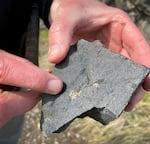
Geologist Nick Zentner points out the orange plagioclase feldspar crystals embedded in the Ginkgo lava flow on March 14, 2023.
Jule Gilfillan / OPB
“I’m serious,” he says. “Like, this is one of the highlight moments for me in the last 35 years!”
The Central Washington University geology instructor is likely familiar to many OPB-TV viewers. His series “Nick on the Rocks” began appearing on OPB in 2019. In the segments, Zentner travels across the Pacific Northwest explaining how various geologic phenomena formed in an approachable, gregarious style that makes something as ostensibly dull as rocks seem fascinating.
His “2 Minute Geology” series and online lectures rack up hundreds of thousands of views, and his YouTube channel has more than 80,000 subscribers, suggesting that his boundless enthusiasm can make even the abstract science of rocks a hot topic.
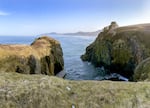
These cliffs at Yaquina Head, pictured here on March 16, 2023, are the terminal land point of the Ginkgo lava flow, which sprang from a fissure 300 miles away in Eastern Washington.
Jule Gilfillan / OPB
On this spring day last year, Zentner was at Yaquina Head near Newport to verify stories he’d heard about a lava flow known as the Ginkgo flow. The flow’s original magma erupted in Eastern Washington some 16 million years ago and supposedly traveled all the way to the Oregon Coast. The thumbnail-sized crystals embedded in the basalt are made up of plagioclase feldspar, a common mineral, and are one of the tell-tale clues that now proves to Zentner that this huge headland is indeed the western edge of the same flow.
The Ginkgo is part of the Columbia River Basalt Group, an epic series of lava flows that blanketed much of the Pacific Northwest over a few million years in the late Miocene epoch.
The 1,000-degree centigrade flow was hot enough to stay fluid beneath the crust that formed on the more rapidly cooling surface for a distance of around 300 miles. Finding valleys and other low-lying areas to follow, the Ginkgo forged a path across southern Washington and northern Oregon in an estimated six days.
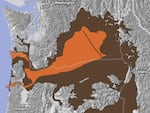
A map of the Ginkgo lava flow showing in black the long fissure from which it erupted and showing the flow path from Eastern Washington to the Pacific coast in orange.
Coutesy of Nick Zentner, Central Washington University
Evidence of it can be seen at Columbia Hills State Park across the Columbia River from The Dalles and at Silver Falls State Park in the Willamette Valley, as well as at its source near Kahlotus, Wash. It’s known as the Ginkgo flow because it happened to encounter and entomb ginkgo tree logs near Vantage, Wash. But that’s not the only thing that makes it unusual.
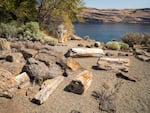
A scattering of petrified ginkgo trees near Vantage, Wash., in 2017. Logs from the once-living forest were entombed by the lava flow that now bears its name.
Daniel Coe, Washington Department of Natural Resources
“The Ginkgo flow erupted during a time when the Earth’s magnetic field was in the process of flipping; the magnetic south was becoming the magnetic north,” Zentner explained. These periods of geomagnetic reversal are known as “chrons” and take several thousand years to complete. Scientists estimate there have been at least 183 of these magnetic reversals over the last 83 million years.
The study of paleomagnetism allows scientists to detect the direction and intensity of Earth’s magnetic fields at the time when rock formed. The presence of this unusual paleomagnetic signature is more evidence that this rock is part of the Ginkgo flow.
“That’s the smoking gun,” declared Zentner.
While Zentner is certain that the Ginkgo did flow all the way from Eastern Washington to the Oregon coast, it’s the constantly evolving science of geology that really piques his interest.
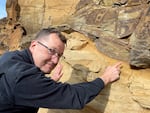
On March 14, 2023, geologist Nick Zentner points to a “moment in time” when the Ginkgo lava flowed on top of the ancient Columbia River some 16 million years ago.
Jule Gilfillan / OPB
“It’s still a bit of a mystery why the Ginkgo flow has these big visible crystals of plagioclase feldspar and why other basalt flows don’t have them visibly,” Zentner said.
Though the crystals do exist in other flows, they are microscopic in scale.
“Something must have been going on down in the magma chamber underground and those crystals were allowed to grow nice and big,” he said.
Mysteries like this will likely keep the Northwest geologist’s enthusiasm flowing for another 35 years.

